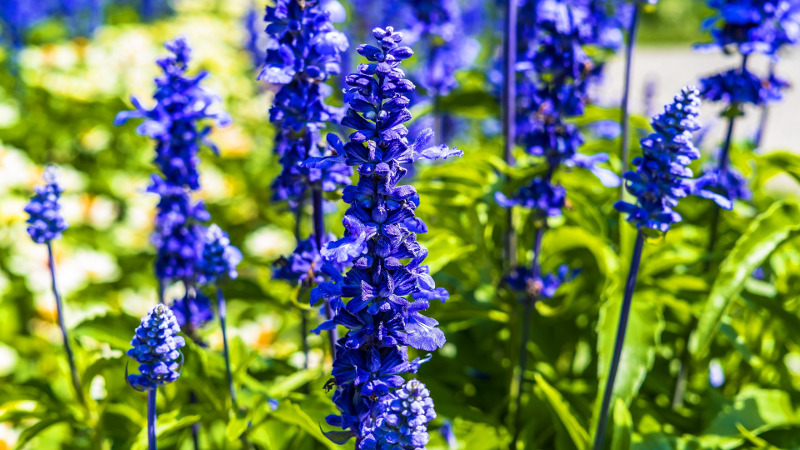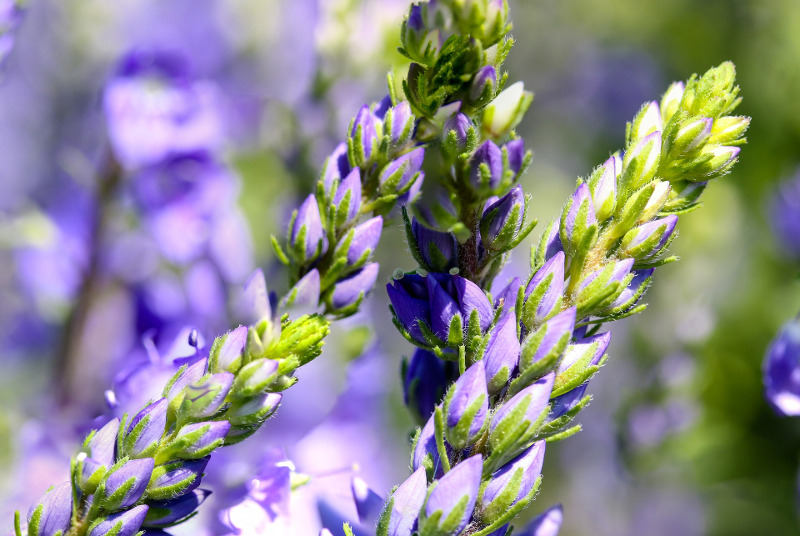Larkspur, also known as Delphinium, is a genus of about 300 species of perennial flowering plants in the family Ranunculaceae, native throughout the Northern Hemisphere and also on the high mountains of tropical Africa. The genus was erected by Carl Linnaeus. Larkspur foliage is silver green on tall stalks surrounded by flower covered spikes. Flower colors include blue, lavender, white and red. Depending on the variety, height ranges from dwarf plants to plants exceeding 6 feet tall.
Larkspurs prefer rich, moist well-drained soil and thrive in full sun to partial shade. Dwarf-sized plants are used in borders, garden beds and containers. Taller varieties are often used as cut flowers and dried arrangements. This herbaceous perennial is hardy in USDA zones 4-8. The genus Delphinium is toxic to humans and livestock.

Planting Larkspur
Larkspurs like well draining soil and full sun for the best blooms. These plants require at least 6 hours of direct sun a day, although shade early or late in the day will be fine. Shade in the late afternoon will help Larkspur to make it through a very hot summer.
Larkspurs can grow very tall and may need staking to support its heavy blooms. This plant self-sows by dropping seeds and will return the following season. If not properly monitored, Larkspur can take over a garden. It is a good idea to space each plant 16 inches apart from each other.
Plant larkspur in rich, well-drained soil. This perennial does not like dry or hot growing climates and performs best in cooler, higher humidity areas. Adding compost to the bottom of the planting hole will give Larkspur the added nutrition it needs at the root zone with less chance of burning delicate root tissue. Water the plants well after planting and then mulch with 2-3 inches of organic matter to retain moisture in the soil.
Watering Larkspur
Larkspur is a fast growing flower and grows best in cooler weather. Typically, delphiniums need regular watering and should not be left to grow in dry soil. These plants never become drought tolerant, even at maturity. Continued moist soil will aid in faster growth. Watering at a rate of 1½ inches of water a week will help Larkspur produce the giant blousy flower spikes they are famous for. Break the watering sessions into 2-3 per week, focusing on longer drinks to encourage the roots to grow deeper in the ground.
Drip irrigation and soaker hoses do an efficient job of getting the water directly where the plant can use it with little evaporation. Be sure that the soil is well draining so the plant is not left sitting in soggy conditions.
Larkspur benefits from regular mulching to help the moisture stay in the soil and cool the root zone. Add a 2 inch layer of mulch to retain moisture in the soil.

Fertilizing Larkspur
Larkspur is a fast-growing plant with multiple blooms, making them heavy feeders. Both the perennial and the annual types require fertilizing on a regular schedule during the growing season. Annual Larkspur will benefit from a diluted liquid feed formulated for tomatoes or roses. These foods have the right balance of N-P-K to encourage profuse blooming without excess foliage. Feed the annual type every 2-3 weeks through August. Perennial Larkspur will need 3 separate fertilizing sessions.
A balanced, slow-release fertilizer early in the spring as the new growth starts should be applied to the soil around the plant, scratched in lightly, and then watered well. When the first flush of flower buds are forming, a liquid or granular tomato or rose food can be applied. This nutrition promotes development of large and bright flowers. Feed one last time about 6 weeks later to support the last flush of flower spikes.
Pruning Larkspur
Larkspurs can benefit from a light pruning each season. The pruning for Larkspur includes deadheading and an annual cut-back in the fall. Light pruning keeps the plant attractive and encourages a second bloom. Remove wilted stalks by cutting when ⅔ of the blooms have wilted. You can also deadhead spent blooms to prevent the plant from forming seeds. Deadheading also encourages more blooms.
If you would like your Larkspur to reseed, refrain from deadheading. A severe cutting in early summer can encourage a second bloom. Pruning helps to winterize the plant as well. Clean-up in the fall or winter involves a quick trim of all the dead top growth to within 1-2 inches of the soil line.
Delphiniums are poisonous to humans and some animals. Properly dispose of excess plant material. Any plant part that is affected by fungus, mildew, or pests should be burned or disposed of in the trash.
Home composting piles rarely produce enough heat to kill off pathogens completely. During the growing season, any foliage or flowers that are eaten by slugs or affected by mildew can be cut off without any damage to the plant. New healthy growth will quickly fill in.
Caring For Larkspur in Pots
Growing Larkspur in containers is easy and useful for small spaces or decks and patios; the tall flower spikes make for a dramatic focal point. It is best to choose a compact variety of Larkspur to grow in a container or pot. Choose a sturdy pot that will not fall over from the weight and height of the stalks of flowers. Your container should have good drainage holes. Once the plant is established, staking may be needed to support the plant.
All-purpose potting soil is best for container-growing perennials. It is light and well drained, allowing the gardener to easily control the watering and fertilizing frequency. Fertilizing needs to be done every 2-3 weeks with a diluted liquid tomato food or rose fertilizer. Plants grown in containers tend to dry out more quickly.
With Larkspur, it is important to keep the soil continually moist but not soggy. Watering should be done before the plant has a chance to dry out. The soil should feel like a tightly wrung-out sponge. Check the moisture levels every other day or daily, depending on the container size, during the height of the summer. Always water plants until water runs out the drainage holes.
Winter Care for Larkspur
Herbaceous perennials like larkspur need minimal winter maintenance. They are exceptionally hardy down to USDA zone 3 and are mostly dormant for the winter months.
As winter approaches, continue to water the plant regularly until the ground freezes. This gives the roots a chance to store water for the cold weather months. During winter, if the ground thaws, your Larkspur will appreciate a drink of water. In areas that have heavy fall and winter rains, supplemental watering is seldom needed.
After fall flowering, cut the plant to the basal leaves, leaving the foliage in place. Cutting off the dead or dying top growth in the fall will help to clean up any plant material that might be affected by mildew, fungus, or pests. Mulch the growth crown thickly with organic material such as straw, arborist chips, or shredded leaves. This mulch will help preserve moisture and insulate the roots from the cold and the snow.
Larkspur For Sale
Common Larkspur Care Questions
Are Larkspur Flowers The Same As Delphiniums?
Delphinium and larkspur, while very closely related, and very similar in appearance, are not the same thing. Delphinium tends to be perennial and larkspur annual, and both are toxic to both humans and livestock.
Does Larkspur Come Back Every Year?
Larkspur is an annual, but can certainly come back every year as it very easily self-seeds, because of this, it is often mistaken as a perennial.
Does Delphinium Spread?
Delphiniums can multiply rapidly so dividing them every few years is good practice.
Does Delphinium Leave Turning Yellow?
Yellow leaves on delphinium might be indicating that the soil is too alkaline and there is an iron deficiency. Iron is best absorbed by the plant when the pH level is between 5 ad 6.5.
What Is The Growth Rate For Delphinium?
Delphiniums grow rather quickly and can reach their mature size in about a year.
Have a question about Larkspur? Fill out the form below and we will try and get back to your question as soon as possible. We may even feature your question on this article to help other gardeners!
 |
Author Chris Link - Published 07-09-2021 |
